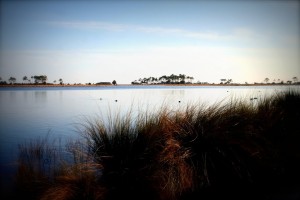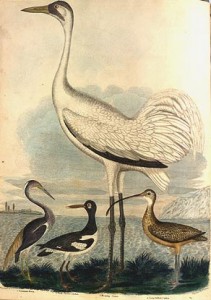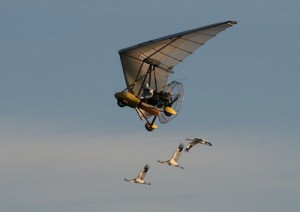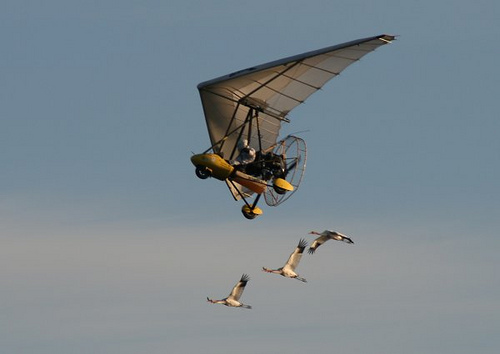 Just once we thought we’d caught a glimpse of white from the horizon, from that far edge between palm trees; a ripple of movement and a rising, the sound of rushing wings and bugled calls: a dream.
Just once we thought we’d caught a glimpse of white from the horizon, from that far edge between palm trees; a ripple of movement and a rising, the sound of rushing wings and bugled calls: a dream.
For centuries, cranes have evoked a strong emotional response… their behavior, unique calls, graceful movements, and stately appearance have inspired art, mythology and legend in cultures around the world.
Their tall, angular figures, made up of so much wing, leg, neck, and bill, counterpoised by so little body, incline the spectator to look upon them as ornithological caricatures. After balancing himself upon one foot for an hour, with the other drawn up close to his scanty robe of feathers, and his head poised in a most contemplative attitude, one of these queer birds will suddenly turn a somersault, and, returning to his previous posture, continue his cogitations as though nothing had interrupted his reflections.
 With wings spread, they slowly winnow the air, rising or hopping from the ground a few feet at a time, then whirling in circles upon their toes, as though going through the mazes of a dance, Their most popular diversion seems to be the game of leap-frog, and their long legs being specially adapted to this sport, they achieve a wonderful success. One of the birds quietly assumes a squatting position upon the ground, when his sportive companions hop in turn over his expectant head. They then pirouette, turn somersaults, and go through various exercises with the skill of gymnasts. Their sportive proclivities seem to have no bounds; and being true humorists, they preserve through their gambols a ridiculously sedate appearance.
With wings spread, they slowly winnow the air, rising or hopping from the ground a few feet at a time, then whirling in circles upon their toes, as though going through the mazes of a dance, Their most popular diversion seems to be the game of leap-frog, and their long legs being specially adapted to this sport, they achieve a wonderful success. One of the birds quietly assumes a squatting position upon the ground, when his sportive companions hop in turn over his expectant head. They then pirouette, turn somersaults, and go through various exercises with the skill of gymnasts. Their sportive proclivities seem to have no bounds; and being true humorists, they preserve through their gambols a ridiculously sedate appearance.
–Nathaniel H. Bishop, Four Months in a Sneak-Box, 1879
 Whooping Cranes exist, now, perilously close to extinction. Various public and private organizations are doing improbable things to rescue them from that sad fate. Cranes historically wintered at only one location: Aransas NWR in Texas, which leaves the entire naturally-occurring population of Whooping Cranes quite vulnerable to disaster. Recovery efforts have thus focused on establishing a second Eastern population of Whoopers that breeds and winters in a separate location. In Florida, I got the chance to meet the ultralight pilot who, as part of Operation Migration, flew a group of twenty cranes from Wisconsin to St. Mark’s NWR and Chassahowitzka NWR to spend the winter there. I also learned (a bit too late!) that the likelihood of seeing a Whooper there is small, as they are secluded away in a far corner of the refuge.
Whooping Cranes exist, now, perilously close to extinction. Various public and private organizations are doing improbable things to rescue them from that sad fate. Cranes historically wintered at only one location: Aransas NWR in Texas, which leaves the entire naturally-occurring population of Whooping Cranes quite vulnerable to disaster. Recovery efforts have thus focused on establishing a second Eastern population of Whoopers that breeds and winters in a separate location. In Florida, I got the chance to meet the ultralight pilot who, as part of Operation Migration, flew a group of twenty cranes from Wisconsin to St. Mark’s NWR and Chassahowitzka NWR to spend the winter there. I also learned (a bit too late!) that the likelihood of seeing a Whooper there is small, as they are secluded away in a far corner of the refuge.
So be it… it’s enough to know that these birds still live in wild places, far beyond the reach of my vision.
For the Whooping Crane there is no freedom but that of unbounded wilderness, no life except its own. Without meekness, without a sign of humility, it has refused to accept our idea of what the world should be like. If we succeed in preserving the wild remnant that still survives, it will be no credit to us; the glory will rest on this bird whose stubborn vigor has kept it alive in the face of increasing and seemingly hopeless odds. –Robert Porter Allen
I’d love to hear your stories of Whoopers, if you have any.

This brought a tear to my eye, Laura. Thank you!
For the first time in my life, I saw whoopers at Aransas NWR when I visited there in December. I was awestruck and dumbfounded to see them, and I sat like a young child watching a magician pull rabbits from a hat. They were in the salt flats preening in early morning fog. Nothing more complicated than that, but it was the most beautiful scene I’d ever rested my eyes upon.
Several Octobers ago, I was walking out to an annex building at the middle school where I worked, just passing between classes. Sandhills frequently fly over western South Dakota by the hundreds during migration, headed for the Platte River. I always stop to admire, they are such an timeless fall happening. I saw a flock of about 100 approaching from the north, against a clear blue and sunny sky. As they got closer, 4 in the middle of the flock looked odd, I suddenly realized that I was looking at whooping cranes! I am sure I stood with my mouth open just staring till they were out of sight. I was very late to geography class, but it was a breath-taking moment that was worth it.
Jason: Thanks for sharing that… I was hoping you’d have an encounter to retell.
Caroline: Gosh… I’d learned that whoopers often fly with a larger group of sandhills, like you say. Sadly, NJ isn’t on their normal migration route, so I don’t expect I’ll ever see them that way. Glad you got to experience them!
Whoopers are on my list of “been there, just missed that incredibly rare bird” list. (“You shoulda been here last week!”) Also, Puffins. Also, Golden-cheeked warblers. Argh.
Rurality: Isn’t that always the way! Gives us something to wish for tho.